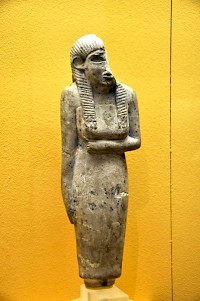Merneith
Merneith (c.2925 BCE): queen of First Dynasty Egypt, wife of King Djet, mother of King Den, probably briefly ruling in her own right.

Queen Merneith lived during Egypt’s Early Dynastic Period and was presumably the great wife of King Djet and mother of King Den. She is named in one of Egypt’s earliest known King Lists, which has led scholars to believe that Merneith may have been a pharaoh in her own right.
Seal impressions in Den’s tomb
The King List referred to above was discovered in the tomb of one of the main kings of Egypt’s First Dynasty: Den. The list consists of several seal impressions naming the rulers of this dynasty: Narmer, Hor-Aha, Djer, Djet, and Den. Another ruler is mentioned as well, namely Merneith, or Merit-Neith. Two separate tombs dedicated to this ruler were uncovered in Saqqara (near the new capital Memphis in Lower Egypt) and in Abydos in Upper Egypt.
Merneith's Tomb in Abydos
The commissioning of two separate tombs was not a common practice during Egypt’s First Dynasty and once Flinders Petrie opened up "Tomb Y" in Abydos in 1900, there was no doubt in his mind that the deceased, whose name had been inscribed on two stelae, was indeed a male king. To start with, the tomb is located in the Umm el-Qaab necropolis of Abydos, the final resting place of the kings of the First and Second Dynasties, and is positioned amongst the tombs of Kings Djet and Den. Moreover, the proportions of this tomb are quite substantial (c. 16.5 x 14 meters).
There is another piece of evidence that indicates the deceased's royal status. During his excavations, Petrie stumbled upon an underground cemetery that contained at least forty burial sites, which surrounded the chamber of the dead ruler. Based on the objects discovered in these graves, it has been concluded that both king's servants had been interred in the king's proximity. The servants were most likely interred at the same time as Merneith, presumably to serve the king in the afterlife: a customary practice concerning first dynasty burials.
Merneith's tomb in Saqqara
Merneith’s second tomb is located in Saqqara (‘Tomb 3503’), the desert plain behind the newly founded city of Memphis. Within the tomb, grave goods were found upon which her name had been written, such as stone vases and jars. In one case, her name appears within a serekh. This rectangular shape - resembling a palace façade with the form of a falcon sitting at its top - was the predecessor of the cartouche that contained the king’s name (or title). This find led archaeologists to believe that they had identified the tomb of a king, and in the vicinity of the tomb even stronger proof was uncovered: a solar barque.
"Beloved of Neith"
Although all evidence pointed in the direction of a male king, it soon became apparent that archaeologists were in fact dealing with a female member of the royal family. The first clue is the ruler’s name itself, Merneith, which is evidently female and means "Beloved of Neith". It refers to the mother goddess Neith, who was a much-worshipped deity in the Predynastic and Early Dynastic Periods.
A final clue identifying Merneith as a woman is a seal from the reign of King Den, which clearly states her title: "Mother of the King". The king referred to must be Den, which means that Merneith may have been the great wife of King Djet.
Whether Merneith, who certainly had two royal tombs, was the first female pharaoh of Egypt, cannot be proved with any certainty. She may have ruled over Egypt for some time as a regent to her son Den, who had not yet come of age. In view of the location and size of her tomb in the Umm el-Qa'ab necropolis of Abydos, the surrounding burial sites of servants, the solar barque unearthed at Saqqara, and the fact that Merneith was the only woman of the First Dynasty for whom two tombs were commissioned, it is clear that she was perceived as an esteemed member of the royal family and enjoyed a high status.